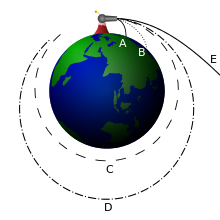
Back كرة نيوتن المدفعية Arabic নিউটনের কামানের গোলা Bengali/Bangla Bala de cañón de Newton Spanish Canon de Newton French Newtonova topovska kugla Serbo-Croatian Isaac Newtons kanonkula Swedish ลูกกระสุนปืนใหญ่ของนิวตัน Thai Newton'ın top güllesi Turkish Thí nghiệm đạn pháo của Newton Vietnamese 牛顿大炮 Chinese

Newton's cannonball was a thought experiment Isaac Newton used to hypothesize that the force of gravity was universal, and it was the key force for planetary motion. It appeared in his posthumously published 1728 work De mundi systemate (also published in English as A Treatise of the System of the World).[1][2]
- ^ De mundi systemate, Isaac Newton, London: J. Tonson, J. Osborn, & T. Longman, 1728.
- ^ A Treatise of the System of the World, Isaac Newton, London: printed for F. Fayram, 1728.